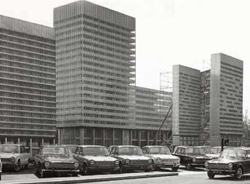
The Raven, Edgar Allan Poe
early interpretations of the unhomely
The feeling of unhomely has been popular in artistic efforts since the late eighteenth century. First appearing in short stories by Edgar Allen Poe and E.T.A. Hoffman. These authors created the sense by contrasting a safe and homely place with the intrusion of an unfamiliar, alien presence. After this, a period emerged with architecture and the uncanny entwined in a struggle with the growing metropolis. This condition was picked up by authors of the time, around the late nineteenth and early twentieth centuries, notably by Baudelaire and Zola. The uncanny successfully manifested itself in the estrangement of the metropolitan mass, and has developed in corners of society through conditions like claustrophobia and agoraphobia. Artists again became interested in this phenomena, and tried to transfer it into their work through techniques of defamiliarisation. At this point one can consider many films today that arouse a sense of discomfort and recognise in it methods of defamiliarisation that result in a disquieting estrangement.
In early films, the manipulation of set was much more limited. Take for example Robert Wiene’s 1920 film, The Cabinet of Dr. Caligari. This was filmed entirely on a physical set, constructed inside a studio space. The set was designed and built to express the deranged quality of the story and narrator. Exaggerated shadows and lighting was created by painting the set, and sharp angles and sloping walls enhance the discomfort of the spaces.
Caligari’s approach may seem primitive now, but the effect is still successful at a present viewing. Jacques Tati, a later director, also used an entirely physical set to film his 1967 film, Playtime. This film, set in Paris, portrays an almost completely unrecognisable future version of the city. For this film, Tati constructed the entire set outside of Paris, in what became known as Tativille. A number of full scale office towers, with glass windows and escalators were constructed, and built on wheels to be rolled around to appear in different shots as if the entire city was built. Only a few references to recognisable Paris allow the viewer to place themselves in the city so famous for its iconography. The disconnect created in this film does not instil a significant sense of uncanny in the viewers because it is conveyed in an extremely playful manner. The more unhomely sense is created by the general ambiguity of many of the scenes in the film. It is often unclear where a scene is taking place, for instance, in the opening scene, whether you are in a hospital, or a school, until it becomes clear the action is taking place in an airport. Many situations like this in the film create an uncertainty about the action and characters, which is discomfiting, and yet still does not provoke strong emotion due to the fact that the film set is so abstract and vaguely reminiscent of something recognisable, as well as due to the light-hearted nature of the film.


